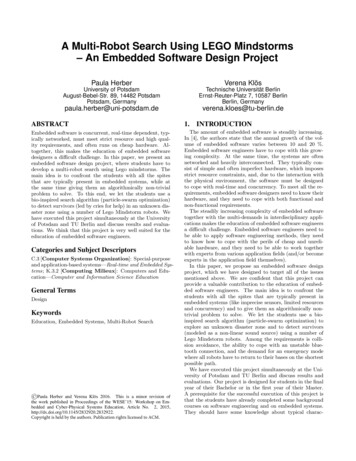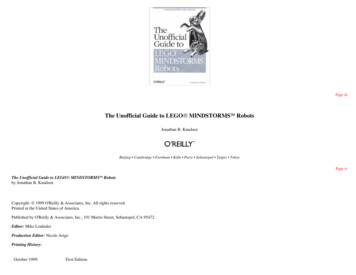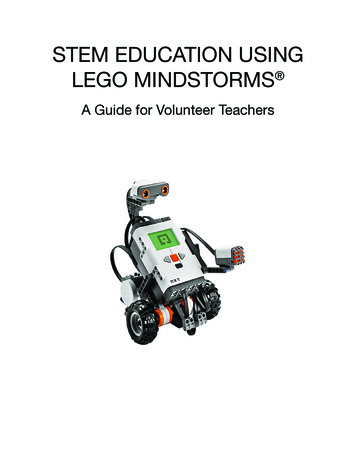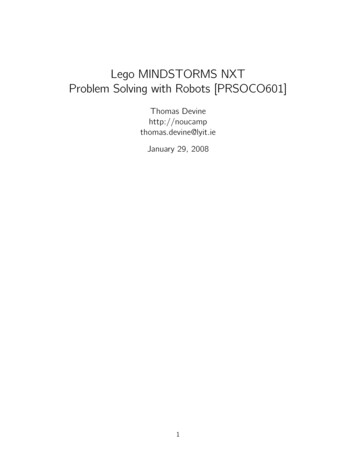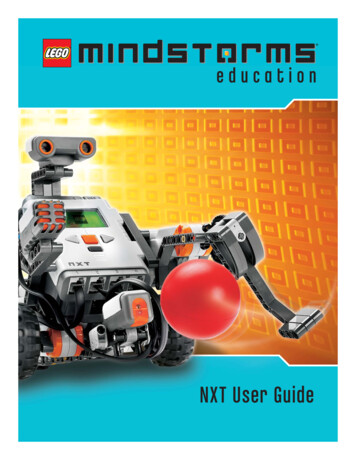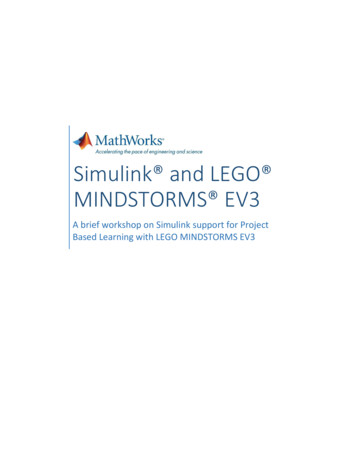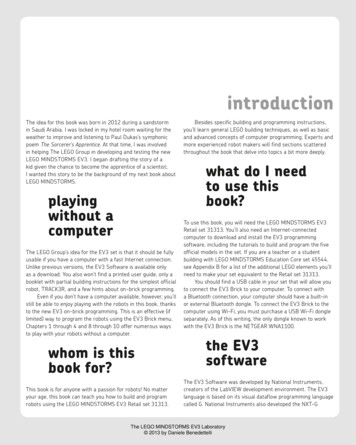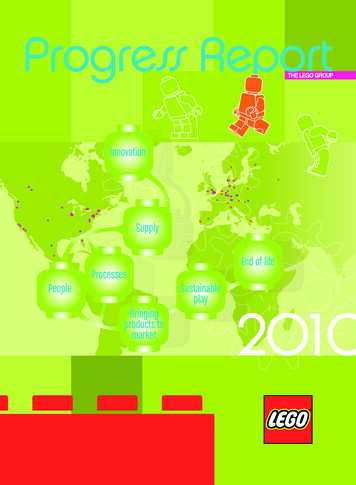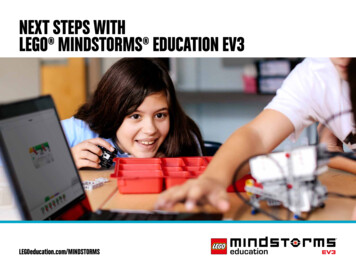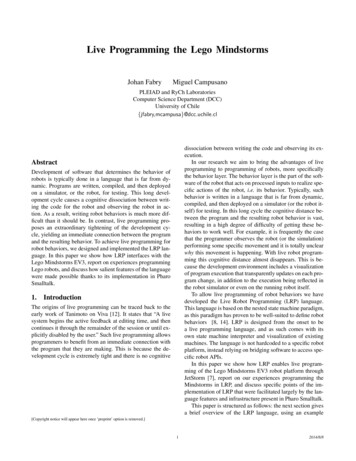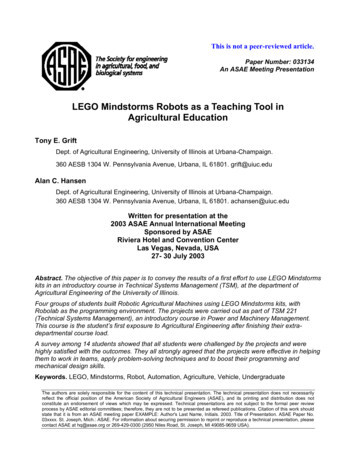
Transcription
This is not a peer-reviewed article.Paper Number: 033134An ASAE Meeting PresentationLEGO Mindstorms Robots as a Teaching Tool inAgricultural EducationTony E. GriftDept. of Agricultural Engineering, University of Illinois at Urbana-Champaign.360 AESB 1304 W. Pennsylvania Avenue, Urbana, IL 61801. grift@uiuc.eduAlan C. HansenDept. of Agricultural Engineering, University of Illinois at Urbana-Champaign.360 AESB 1304 W. Pennsylvania Avenue, Urbana, IL 61801. achansen@uiuc.eduWritten for presentation at the2003 ASAE Annual International MeetingSponsored by ASAERiviera Hotel and Convention CenterLas Vegas, Nevada, USA27- 30 July 2003Abstract. The objective of this paper is to convey the results of a first effort to use LEGO Mindstormskits in an introductory course in Technical Systems Management (TSM), at the department ofAgricultural Engineering of the University of Illinois.Four groups of students built Robotic Agricultural Machines using LEGO Mindstorms kits, withRobolab as the programming environment. The projects were carried out as part of TSM 221(Technical Systems Management), an introductory course in Power and Machinery Management.This course is the student’s first exposure to Agricultural Engineering after finishing their extradepartmental course load.A survey among 14 students showed that all students were challenged by the projects and werehighly satisfied with the outcomes. They all strongly agreed that the projects were effective in helpingthem to work in teams, apply problem-solving techniques and to boost their programming andmechanical design skills.Keywords. LEGO, Mindstorms, Robot, Automation, Agriculture, Vehicle, UndergraduateThe authors are solely responsible for the content of this technical presentation. The technical presentation does not necessarilyreflect the official position of the American Society of Agricultural Engineers (ASAE), and its printing and distribution does notconstitute an endorsement of views which may be expressed. Technical presentations are not subject to the formal peer reviewprocess by ASAE editorial committees; therefore, they are not to be presented as refereed publications. Citation of this work shouldstate that it is from an ASAE meeting paper EXAMPLE: Author's Last Name, Initials. 2003. Title of Presentation. ASAE Paper No.03xxxx. St. Joseph, Mich.: ASAE. For information about securing permission to reprint or reproduce a technical presentation, pleasecontact ASAE at hq@asae.org or 269-429-0300 (2950 Niles Road, St. Joseph, MI 49085-9659 USA).
IntroductionInformation and Automation Technology will be part of the future careers of virtually all studentsin Agricultural Engineering. Traditionally students are exposed to a course in a higher ordercomputer language, which is perceived by many students as unexciting and tedious. Tointroduce students to automation in a far more challenging and exciting manner, LEGOMindstorms were used in TSM 221.The LEGO Mindstorms kits contain a programmable brick which essentially is a micro controller(Hitachi H8/300L) built in a plastic LEGO package with three connectors for actuators (motors)and three sensor inputs such as switches, optical analog sensors, angle encoders etc. Themicro controller has an infrared serial link through which programs can be uploaded andexecuted. The brick also has buttons to start, stop, and select programs and to check the statusof actuators and sensors in real time.The Mindstorms brick can be programmed in a variety of languages. LEGO supplies itsproprietary pictorial ladder-style language, there is NQC (Not Quite C), which is a C-derivative,and advanced users can even use C/C that runs on a dedicated operating system calledBrickOS. The programming environment used in TSM221 was Robolab, a simplified version ofLabView developed by National Instruments in cooperation with LEGO’s educational divisionDacta and Tufts University. Robolab is a pictorial programming environment, where actuators,sensors and control structures are joined together showed to be very suitable for students withno procedural language background. The reason for selecting this language was thewidespread use of LabView in industry and the basic philosophy behind it. Users selectcomponents and attach modifiers to change their properties. Components are linked using awiring tool very similar to building electrical circuits.TSM221 is a course in Farm Power and Machinery Management. Although the text used for thiscourse (Hunt, 2001) does not elaborate on Automation, examples were used from the book toset the stage for the problem to be solved using the LEGO robots. Variable Rate Applicationequipment is a essential component of the Precision Agriculture paradigm. For this reason oneassignment was the development of a Variable Rate spreader that could sense soil parametersand adjust the application rate accordingly. A second group was assigned the task to develop aself-guided tractor to tow the Variable Rate spreader. Two other groups worked on harvestingoptimization based on examples from Hunt’s text.The objectives of the LEGO Mindstorms projects were:1) To introduce the concepts of Automation to undergraduate students in TSM2) Develop communication skills among students3) Exercise critical thinking and engineering design principles4) Promote enthusiasm for studying engineering5) Develop skills of graphical programming6) Enforce precision agriculture concepts7) Promote creativity and engaged learning8) Experience the feeling of accomplishment by completing a group design2
Description of projectsProject 1: Self guided tractorTeam 1 was given the assignment of developing an autonomous tractor that was guided by ablack line, drawn on a board. The group was given this assignment to make sure group 2 (whichdeveloped a Variable Rate spreader) had a vehicle to pull their implement. Although in it selfperhaps technically the least challenging project, communication between the two groups wasessential for a satisfactory outcome. The principle of following the black line was implementedusing two optical sensors, which detected the difference between the black line and the whitebackground. When the sensor on the right side would detect the black line it would turn off theright side motor and steer the vehicle left, back toward the line. When a motor was turned off,the tractor would beep to indicate activity in the control loop. The challenge of the self-guidedtractor was the narrow turn radius required. The group had to build the tractor extremely shortand use rear wheel steering to allow for this turning radius. The weight distribution was also anissue, since the design of the Variable Rate spreader applied a significant amount of weight onthe drawbar of the tractor.Figure 1 Group 1 working on a Self-Guided Tractor3
Project 2: Variable Rate Applicator (VRA)The variable rate applicator was assigned to promote thinking about site-specific application.The group needed to cooperate intensely with group 1, since their tractor had to pull the VRAmachine. This resulted in heated discussions about the proper weight distribution, the hitchconfiguration and the narrow turning radius limitations.The VRA group painted a green background with different shades of yellow, red and brown toindicate differences in soil properties. The design as shown in figure 2, is using an opticalsensor that senses the different colors in the soil surface. The program completely shut off thebelt and spinners when the color green (background) was sensed and turned the belt andspinners at different rates when other colors were encountered. This procedure required quitesome time in calibration and it was found that the LEGO supplied optical sensor has limitedcapabilities in detecting different colors. The spreader mechanism was tested with soybeans;other options such as rice, grains and fertilizer were considered but were discarded because oftheir flow properties and chemical aggressiveness.Figure 2 Group 2 working on a Variable Rate Applicator4
Project 3: Optimization of turning an offset harvester through 90 degreesThe two remaining teams Group 3 and 4, were assigned the task of demonstrating the problemof cornering during harvesting operations. Hunt’s text illustrates the problem of backing up overcrop while harvesting with an offset towed harvester. The graphs that show the path of theextreme parts of the machine in the text are hard to understand and replicate. To illustrate thisproblem, it was proposed to use a model tractor to mimic the cornering process andautomatically draw the graphs. This was perceived as not challenging enough and the groupdecided to try to steer the tractor differently so no crop would be left standing after the turn.Although it is questionable whether this is possible at all, the group struggled with it and came tothe conclusion that it was not possible by time-based steering without position feedback. Group3, which had one member from the department of Industrial Design, spent much time on makingthe tractor resemble their favorite brand and model.Figure 3 Group 3 developing an optimized system to steer an offset harvesterthrough a 90 degree corner without leaving any crop standing5
Project 4: Automated farm conceptGroup 4 initially was assigned a project to illustrate the 270-degree turn that a self-propelledharvester employs. This again, was not perceived as challenging enough, so the groupelaborated and developed the concept of a self-propelled autonomous machine that leaves theshed, enters the field, performs a harvesting operation using several 270 degree turns, andreturns to the shed. This goal was not met completely, because of the lack of position feedbackeven after experimentation with different wheels and tracks.Figure 4 Group 4 working on an automated farming concept6
Assessment of LEGO projects effectivenessThe project was carried out in the fall of 2002. Towards the end of the projects, an informalevaluation showed that the far majority of the students found the projects worthwhile. In thesurvey there were 7 questions with responses from ‘Strongly Agree’, ‘Agree’, ‘No Opinion’,‘Disagree’ and ‘Strongly Disagree’. An additional four questions requested a written response.The survey was completed by 13 out of 14 enrolled students.Table 1. List of questions in student survey1. The LEGO projects were effective in helping me understand and apply problem-solving techniques.2. I thought that building our LEGO robots provided an effective way to learn to work in a team3. As a result of this project, I was able to meet and get to know other students4. I developed skills such as programming and mechanical design that I did not have before the project5. I spent more time on this project than I could really afford6. My enthusiasm to study technical systems management has increased due to the LEGO projects7. I found LEGO projects to be satisfying and challengingFigure 5 shows the results of the survey. Questions 1 and 2 clearly indicate that the LEGOprojects were perceived to be effective in practice problem solving techniques and teamwork.Question 3 shows that some students met and interacted with other students more pronouncedbecause of the projects.Question 4 shows that the far majority developed skills that they did not have before theprojects.Question 5 shows that almost all students disagreed in spending too much time in the projects.All students agreed that they found the projects satisfying and challenging and also that theirenthusiasm for studying TSM had increased, as can be seen from questions 6 and 7.Another lesson learned from the projects is to allow more freedom in the problem descriptions.The overall opinion was that the projects were too strict, the students felt limited in what theycould do. In hindsight, it might have been better to limit the scope of application to ‘FuturisticFarming’, rather than having the projects clearly defined.7
90%80%Percentage Responded70%60%50%40%30%20%10%0%1234567Survey QuestionsStrongly agreeAgreeNo opinionDisagreeStrongly disagree1. The LEGO projects were effective in helping me understand and apply problem-solving techniques.2. I thought that building our LEGO robots provided an effective way to learn to work in a team3. As a result of this project, I was able to meet and get to know other students4. I developed skills such as programming and mechanical design that I did not have before the project5. I spent more time on this project than I could really afford6. My enthusiasm to study technical systems management has increased due to the LEGO projects7. I found LEGO projects to be satisfying and challengingFigure 5, Student evaluation summary of LEGO projectsSome other notable comments:“I was extremely satisfied and pleased with this project and the outcome. This was the firstproject in a long time that I was thoroughly enthusiastic about working on. It was stimulating,challenging, and fun. I did not ever mind staying late in the lab playing with it.”“I’m very pleased with the project. It combined mechanical and computer aspects. It gave usexperience working with a team. I also think our project turned out well.”“I think the guidelines for the projects should be broadened so that students can be morecreative in coming up with new techniques or ideas that could actually be used in real life. Bybroadening the guidelines, it will allow for more students creativity but will also require moreprofessor monitoring to ensure that students are actually doing something on their project.”8
“Try some different things with the projects. Different combinations, different programs, ordifferent equipment. Using the camera with the projects could be interesting too.”Future plansThe guidance of a robot showed problematic when no guidelines are provided on the board.Team 4, which built a demonstration of an automated farm, had major problems withreproducibility of the programmed robot trajectories that changed depending on the batterycharge level and changes in the board-track friction. In future generations, a location feedbackwill be used in the form of a camera. The camera will be able to track the vehicle and downlinksteering correction information to the vehicle through the infrared link. A drawback of thisinfrared link is the requirement of a direct line of sight. A much better system would contain anomni-directional radio control system, although this method requires some kind of vehicleseparation through addressing.In the future, the LEGO vehicles will be complemented with CAN bus communication. This willallow students to expand the possibilities of the LEGO bricks and also to program CAN systemsusing BASIC, C or assembly. CAN nodes can be constructed using very small componentssuch as an 8-pin PIC12C67X micro controller combined with a 18-pin AN2551 Transceiver chip(Microchip, http://www.microchip.com, Document AN215). Microchip also has RF chipsavailable such as the rfPIC12F675 that allow short-range wireless communication betweenmicro-controllers.ConclusionsLEGO Mindstorms kits were used as a tool to introduce automation concepts at theundergraduate level in Technical Systems Management (TSM) 221. Robolab, a programmingenvironment similar to LabView, was used as the programming tool. Four robotic machineswere developed to emphasize the merit of using Automation Technology in PrecisionAgriculture.Two groups worked in a self-guided tractor, combined with a Variable Rate Applicator. The thirdgroup developed an optimized system for 90-degree turns during harvesting with an off-setharvester. The fourth group developed a self-propelled machine that left the farmstead, carriedout harvesting tasks in the field and returned to the farmstead without human intervention.The first introduction of automation at the undergraduate level was very well received. Theconclusions of a survey were that the students felt they gained valuable experience in problemsolving and team work. The students felt that the projects were too limiting, they expressed theneed for more freedom to be creative and exploring.ReferencesHunt, D. 2001. Farm Power and Machinery Management, 10th Edition. Publ. Iowa UniversityPress, Ames, IA, US9
Four groups of students built Robotic Agricultural Machines using LEGO Mindstorms kits, with Robolab as the programming environment. The projects were carried out as part of TSM 221 (Technical Systems Management),
